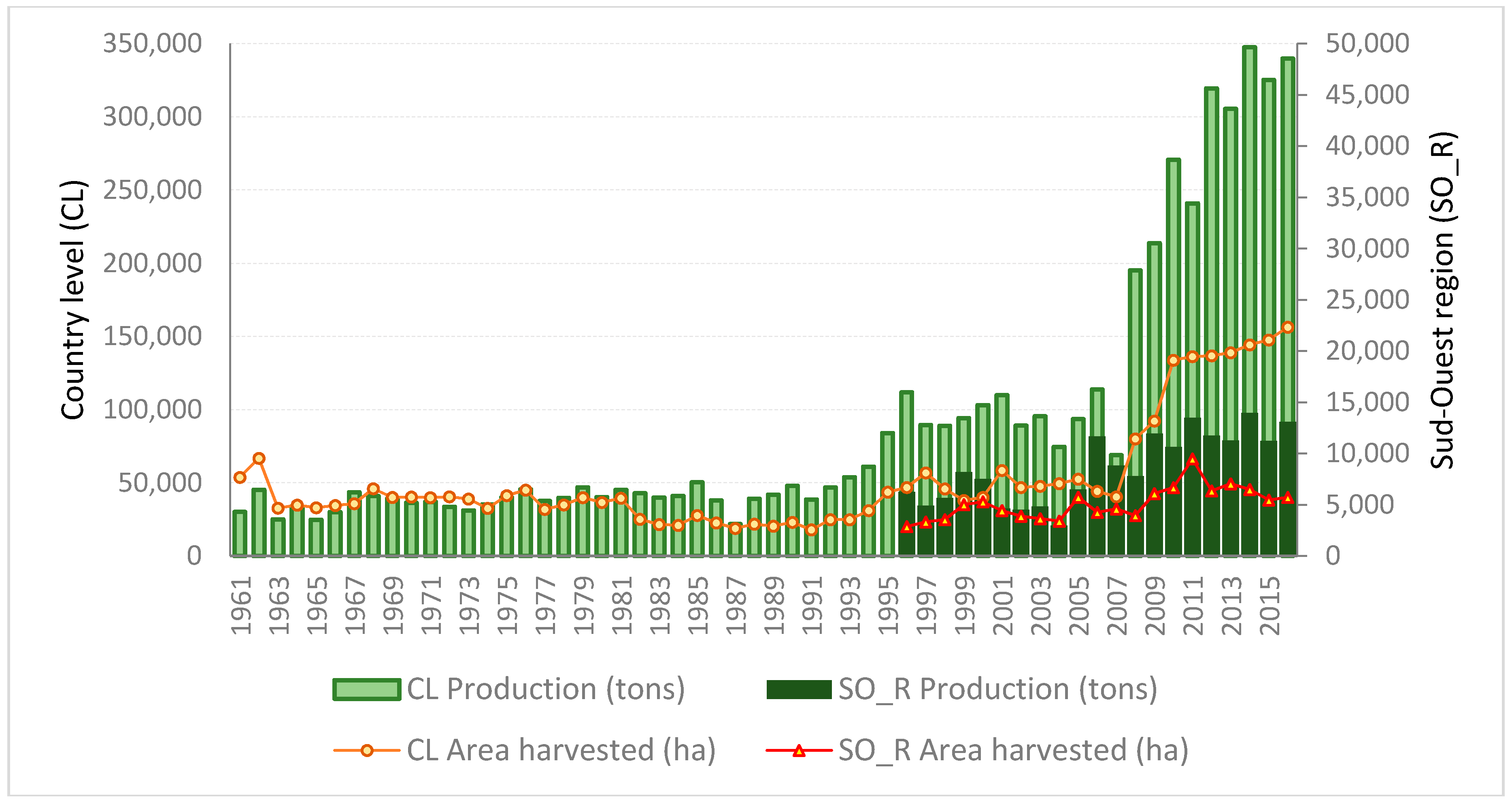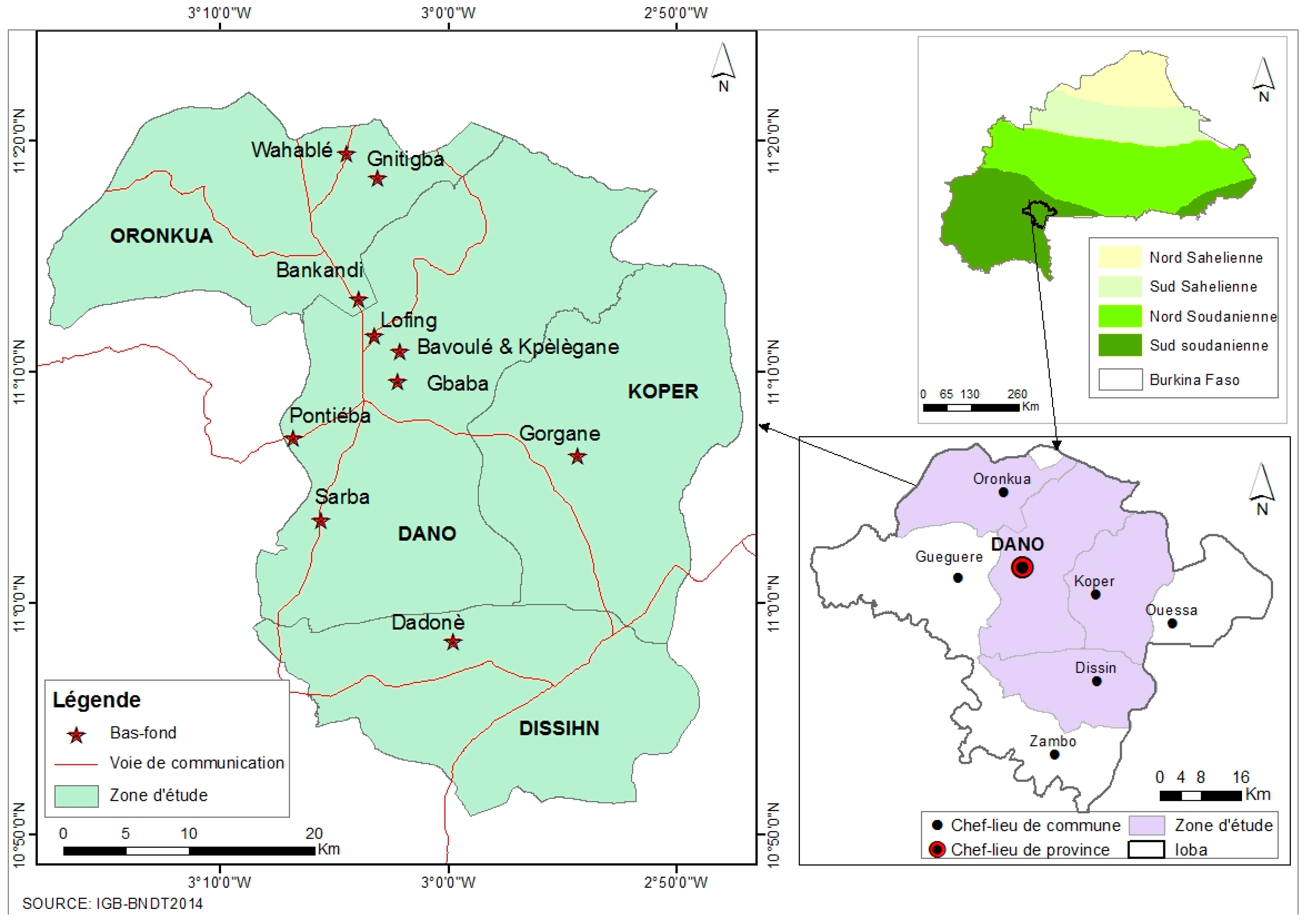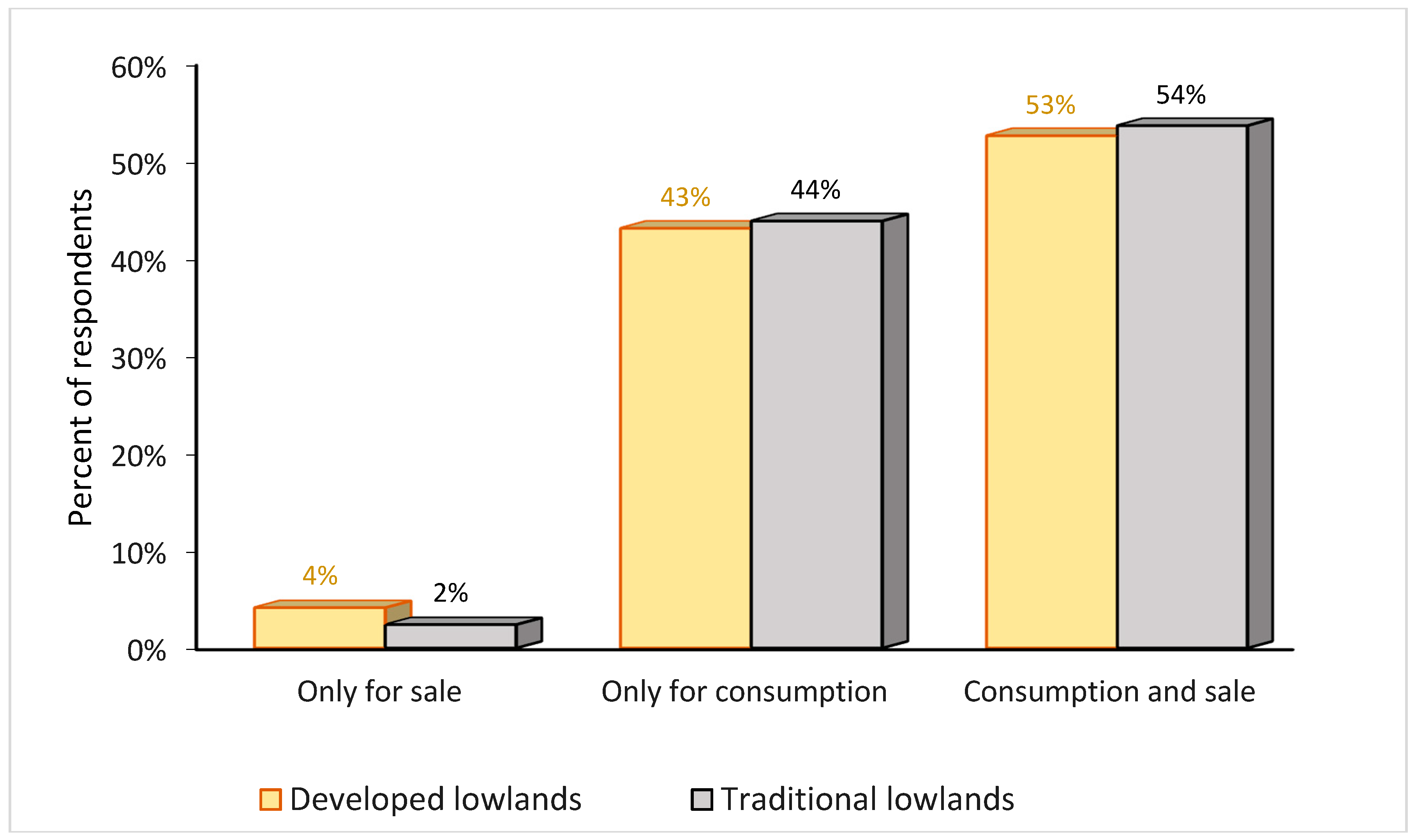Socio-Economic Factors Influencing Small-Scale Farmers’ Market Participation: Case of Rice Producers in Dano
Abstract
1. Introduction
2. Overview of Rice Production in Burkina Faso
2.1. Evolution of Rice Production
2.2. Study Areas Farmers’ Market Participation
3. Materials and Methods
3.1. Material
3.1.1. Sampling Procedure, Data Collection and Analysis
3.1.2. Study Area Description
3.2. Empirical Model and Model Variables
3.2.1. Theoretical Framework
3.2.2. Empirical Model
4. Results and Discussion
4.1. Socio-Economic Characteristics of Lowland Rice Producers
4.2. Statistical Analysis of Rice Production in the Surveyed Lowlands
4.2.1. Lowlands Rice Use in the Study Area
4.2.2. Rice Production by Type of Lowlands
4.2.3. Rice Production by Gender
4.3. Results of the Probit Model
4.4. Discussion
5. Conclusions
Author Contributions
Funding
Acknowledgments
Conflicts of Interest
Appendix A
| Rural Communes | Lowlands | Types of Lowlands | Year of Development | Lowlands Development Projects |
|---|---|---|---|---|
| Dano | Gbagba | DL | 2016 | Dreyer Foundation |
| Lofing | DTL | 2013 | Dreyer Foundation | |
| Pontiéba | DL | 1999 | Project to develop the South-Western Lowlands (PABSO) | |
| Sarba | DL | 2007 | Action Plan for the Rice Sector (PAFR) | |
| Bavoulé & Pkèlgane | DL | 2014/2016 | 1-Dreyer Foundation | |
| 2013 | 2-Productivity and Food Security Improvement Project (PAPSA) | |||
| Dissin | Dadoné | DTL | 2009 | Project to develop the South-Western Lowlands (PABSO) |
| Oronkua | Wahablé | DTL | 1997 | CISV NGO |
| Gnigteba | DTL | 2016 | Project to develop the South-Western Lowlands (PABSO) | |
| Bankandi | DTL | 2006 | Action Plan for the Rice Sector (PAFR) | |
| Koper | Gorgane | DTL | 2007 | Rainfed Rice Project (PRP) |
References
- World Bank. Burkina Faso—Growth and Competitiveness Credit (1–4); Project Performance Assessment Report 127424; World Bank: Washington, DC, USA, 2018. [Google Scholar]
- Pale, S.; Da, D.E.C. Traditional Lowlands Water Management in Dano, South-Western Burkina Faso. J. Water Resour. Prot. 2016, 8, 425. [Google Scholar] [CrossRef]
- Savonnet, G. Pina: Étude D’un Terroir de Front Pionnier en Pays Dagari (Haute Volta). 1970. Available online: http://www.documentation.ird.fr/hor/fdi:05878 (accessed on 11 March 2018). (In French).
- Pradeau, C. Adaptabilité d’une agriculture tropicale traditionnelle: Le pays Dagari (Haute-Volta). Études Rurales 1975, 58, 7–28. (In French) [Google Scholar] [CrossRef]
- Legoupil, J.-C.; Lidon, B. La Mise en Valeur des Bas-Fonds en Afrique Sub-Saharienne: Un Enjeu Important lié à la Connaissance et à la Maîtrise de Leurs Régimes Hydriques. 1995. Available online: http://agritrop.cirad.fr/467960/ (accessed on 2 March 2018). (In French).
- Fiéloux, M.; Lombard, J.; Kambou-Ferrand, J.-M. Images d’Afrique et Sciences Sociales: Les Pays Lobi, Birifor et Dagara (Burkina Faso, Côte-d’Ivoire et Ghana): Actes du Colloque de Ouagadougou, 10–15 Décembre 1990, Karthala Edition ed; ORSTOM: Paris, France, 1993; ISBN 2-7099-1120-5. (In French) [Google Scholar]
- Dorée, A. Gérer les Nouveaux Risques des Bas-Fonds Soudaniens (Dano, Burkina Faso). Mémoire de fin D’étude; Institut National d’Etudes Supérieures Agronomiques de Montpellier (Montpellier SupAgro): Montpellier, France, 2017. (In French) [Google Scholar]
- Thiombiano, T. La controverse empirique et théorique posée par le comportement des producteurs-consommateurs. Rev. Tiers Monde 1997, 38, 821–836. (In French) [Google Scholar] [CrossRef]
- Tollens, E. Wholesale markets in African cities: Diagnosis, role, advantages, and elements for further study and development. FAO Agric. Serv. Bull. 2000, 143, 1–13. [Google Scholar]
- Barrett, C.B. Smallholder market participation: Concepts and evidence from eastern and southern Africa. Food Policy 2008, 33, 299–317. [Google Scholar] [CrossRef]
- Chattopadhyay, M. Ipsita Sen Marketable Surplus and Size-Classes of Holdings. Econ. Polit. Wkly. 1988, 23, A151–A156. [Google Scholar]
- Sharma, V.P.; Wardhan, H. Marketed and Marketable Surplus of Major Food Grains in India; Springer: Berlin/Heidelberg, Germany, 2017; ISBN 81-322-3708-0. [Google Scholar]
- Upender, M. Marketable and Marketed Surplus in Agriculture: A Study at Farm Land; Mittal Publications: Delhi, India, 1990; ISBN 978-81-7099-232-5. [Google Scholar]
- Abafita, J.; Atkinson, J.; Kim, C.S. Smallholder Commercialization in Ethiopia: Market Orientation and Participation. Int. Food Res. J. 2016, 23, 1797. [Google Scholar]
- Ohen, S.B.; Etuk, E.A.; Onoja, J.A. Analysis of market participation by rice farmers in southern Nigeria. J. Econ. Sustain. Dev. 2013, 4, 6–11. [Google Scholar]
- Poole, N. Smallholder Agriculture and Market Participation; Practical Action Publishing: Rugby, UK, 2017; ISBN 1-85339-940-X. [Google Scholar]
- Makhura, M.T. Overcoming Transaction Costs Barriers to Market Participation of Smallholder Farmers in the Northern Province of South Africa, Department of Agricultural Economics, Extension and Rural Development-Faculty of Natural and Agricultural Sciences; University of Pretoria: Pretoria, South Africa, 2001. [Google Scholar]
- Arias, P.; Hallam, D.; Krivonos, E.; Morrison, J. Smallholder Integration in Changing Food Markets; Food and Agriculture Organization of the United Nations: Rome, Italy, 2013. [Google Scholar]
- Gani, O.; Hossain, E. Market participation decision of smallholder farmers and its determinants in Bangladesh. Ekonomika Poljoprivrede 2015, 62, 163–179. [Google Scholar] [CrossRef]
- Von Braun, J.; De Haen, H.; Blanken, J. Commercialization of Agriculture under Population Pressure: Effects on Production, Consumption, and Nutrition in Rwanda; International Food Policy Research Institution: Washington, DC, USA, 1991; ISBN 0-89629-087-5. [Google Scholar]
- Achandi, E.L.; Mujawamariya, G. Market participation by smallholder rice farmers in Tanzania: A double hurdle analysis. Stud. Agric. Econ. 2016, 118, 112–115. [Google Scholar] [CrossRef]
- Yaméogo, T.B.; Fonta, W.M.; Wünscher, T. Can Social Capital influence Smallholder Farmers’ Climate-Change Adaptation Decisions? Evidence from Three Semi-Arid Communities in Burkina Faso, West Africa. Soc. Sci. 2018, 7, 33. [Google Scholar] [CrossRef]
- Adger, W.N. Social capital, collective action, and adaptation to climate change. In Der Klimawandel; Springer: Berlin/Heidelberg, Germany, 2010; pp. 327–345. ISBN 3-531-15925-9. [Google Scholar]
- Gyau, A.; Franzel, S.; Chiatoh, M.; Nimino, G.; Owusu, K. Collective action to improve market access for smallholder producers of agroforestry products: Key lessons learned with insights from Cameroon’s experience. Curr. Opin. Environ. Sustain. 2014, 6, 68–72. [Google Scholar] [CrossRef]
- Bazié, Y.G.; Guissou, S.R.; Ilboudo, W.F.; Mas Aparisi, A. Analyse des incitations par les prix pour riz au Burkina Faso. Série Notes Tech. 2014, 62. (In French) [Google Scholar]
- Guissou, R.; Ilboudo, F. Analyse des incitations et pénalisations pour le riz au Burkina Faso. Sér. Notes Tech. 2012, 44, 1–44. (In French) [Google Scholar]
- Bila, N.K. Revue Documentaire des Etudes sur L’état des Lieux de la Filière riz au Burkina Faso; Comité Inter Professionnel du Riz (CIR-B): Ouagadougou, Burkina Faso, 2016; p. 80. (In French) [Google Scholar]
- Drabo, I.; Ilboudo, F.; Tallet, B. Dynamique des Populations, Disponibilités en Terres et Adaptation des Régimes Fonciers: Le Burkina Fao, une etude de cas; Marchal, J.-Y., Ed.; Comité International de Coopération Dans les Recherches Nationales en Démographie: Ouagadougou, Burkina Faso, 2003. (In French) [Google Scholar]
- SP/CONEDD. Troisième Rapport sur L’état de l’Environnement au Burkina (REEB3); Sécrétariat Permanent du Conseil National de l’Environnement et du Développement Durable (SP/CONEDD): Ouagadougou, Burkina Faso, 2010; p. 263. (In French) [Google Scholar]
- Meyer, J.R.; Kuh, E. The Investment Decision: An Empirical Study; Harvard University Press: Cambridge, MA, USA, 1957. [Google Scholar]
- Norris, P.E.; Batie, S.S. Virginia farmers’ soil conservation decisions: An application of Tobit analysis. South. J. Agric. Econ. 1987, 19, 79–90. [Google Scholar] [CrossRef]
- Greene, W.H. Econometric Analysis, 7th ed.; Prentice Hall: Upper Saddle River, NJ, USA, 2011; ISBN 81-7758-684-X. [Google Scholar]
- Food and Agriculture Organization. Analyse de la Compétivité de la Filière Riz Local au Burkina Faso; Food and Agriculture Organization: Rome, Italy, 2009. (In French) [Google Scholar]
- Addison, M.; Edusah, S.E.; Sarfo-Mensah, P. Gender Constraints and Rice Varietal Characteristics Preferences in Lowland Rice Ecosystem in Ghana. Dev. Country Stud. 2014, 4, 15. [Google Scholar]
- Rahman, S.A. Women’s involvement in agriculture in northern and southern Kaduna State Nigeria. J. Gend. Stud. 2008, 17, 17–26. [Google Scholar] [CrossRef]
- Okam, C.; Yusuf, O.; Abdulrahman, S.; Suleiman, A. Comparative analysis of profitability of rice production among men and women farmers in Ebonyi State Nigeria. Asian J. Agric. Ext. Econ. Sociol. 2016, 10, 1–7. [Google Scholar] [CrossRef]
- Sigei, G.; Bett, H.; Kibet, L. Determinants of Market Participation among Small-Scale Pineapple Farmers in Kericho County, Kenya. 2014. Available online: https://mpra.ub.uni-muenchen.de/56149/ (accessed on 20 September 2018).
- Boniphace, N.S.; Fengying, N.; Chen, F. An analysis of factors affecting smallholder rice farmers’ level of sales and market participation in Tanzania: Evidence from national panel survey data 2010–2011’. J. Econ. Sustain. Dev. 2014, 5, 185–204. [Google Scholar]
- Deininger, K.; Feder, G. Land registration, governance, and development: Evidence and implications for policy. World Bank Res. Obs. 2009, 24, 233–266. [Google Scholar] [CrossRef]
- Maddison, D. The Perception of and Adaptation to Climate Change in Africa; The World Bank: Washington, DC, USA, 2007. [Google Scholar]
- Katungi, E.; Akankwasa, K. Community-Based Organizations and Their Effect on the Adoption of Agricultural Technologies in Uganda: A Study of Banana (Musa spp.) Pest Management Technology. Acta Hortic. 2010, 719–726. [Google Scholar] [CrossRef]
- Saysay, L.J. Profit Efficiency among Smallholder Rice Farmers in Bein Garr and Panta Districts, Central Liberia; Sokoine University of Agriculture: Morogoro, Tanzania, 2016. [Google Scholar]
- Otieno, Z.; Okello, J.; Nyikal, R.; Mwang’ombe, A.; Clavel, D. The role of varietal traits in the adoption of improved dryland crop varieties: The case of pigeon pea in Kenya. Afr. J. Agric. Res. 2011, 6, 176–193. [Google Scholar]
- Wambugu, S.; Okello, J.; Nyikal, R. Effect of Social Capital on Performance of Smallholder Farmer Organizations in Western Kenya. J. Agric. Sci. Technol. 2010, 4, 6. [Google Scholar]
- Abdul-Hanan, A.; Ayamga, M.; Donkoh, S.A. Smallholder adoption of soil and water conservation techniques in Ghana. Afr. J. Agric. Res. 2014, 9, 539–546. [Google Scholar]
- Cheek, L. The Effect of Social Desirability Bias on Willingness-To-Pay for Organic Beef. 2007. Available online: https://ageconsearch.umn.edu/bitstream/113240/2/Paper4.pdf (accessed on 8 March 2018).
- Leggett, C.G.; Kleckner, N.S.; Boyle, K.J.; Dufield, J.W.; Mitchell, R.C. Social desirability bias in contingent valuation surveys administered through in-person interviews. Land Econ. 2003, 79, 561–575. [Google Scholar] [CrossRef]



| Variable | Description of Variables | Mean | Min | Max |
|---|---|---|---|---|
| Gender | 1 if male respondent; 0 if female | 0.67 | 0 | 1 |
| Age | Age of the respondent (Continuous) | 43.56 | 18 | 75 |
| Level of Education | 1 if illiterate, 2 if formal education, 3 if informal education (vocational school or others) | 1.76 | 1 | 3 |
| Working people | Number of working people in the household (Continuous) | 5.86 | 1 | 28 |
| People in charge | Number of people in charge (Continuous) | 8.73 | 0 | 30 |
| Output market | 1 if there is a potential buyer (secured market outlets); 0 if otherwise | 0.25 | 0 | 1 |
| Cotton farmers | 1 if cotton farmers; 0 if otherwise | 0.63 | 0 | 1 |
| Age of Infrastructure | 1 if the water control facility has been done less than 10 years; 0 if otherwise | 0.59 | 0 | 1 |
| Membership | 1 if member in farmers’ organizations; 0 if otherwise | 0.85 | 0 | 1 |
| Functionality | 1 if the lowland with functional rice farmers’ organization | 0.49 | 0 | 1 |
| Type of Lowland | 1 if developed lowland; 0 if otherwise | 0.78 | 0 | 1 |
| Marketable Surplus | Market participation index; 1 if farmer is able to produce 20 kg of rice per person per year; 0 if otherwise | 0.80 | 0 | 1 |
| Developed Lowlands | Traditional Lowlands | F-Test | t-Test | Welch’s t-Test | |
|---|---|---|---|---|---|
| Average rice area (ha) | 0.26 | 0.55 | *** | NA | ** |
| Average production (kg) | 479.85 | 459.37 | *** | NA | NSD |
| Average yield (kg/ha) | 2118.24 | 1300.52 | *** | NA | *** |
| Female | Male | F-test | t-Test | Welch’s t-Test | |
|---|---|---|---|---|---|
| Average rice area (ha) | 0.25 | 0.27 | NSD | NSD | NA |
| Average production (kg) | 414.33 | 530.81 | NSD | * | NA |
| Average yield (kg/ha) | 1599.55 | 2497.29 | *** | NA | ** |
| Step 1 | Step 2 | Step 3 | ||||
|---|---|---|---|---|---|---|
| Coef. | Marg. Effect | Coef. | Marg. Effect | Coef. Std. Err. | Marg. Effect | |
| Marketable Surplus | 0.987 *** (0.296) | 0.377 *** | 0.832 *** (0.304) | 0.323 *** | 0.924 ** (0.381) | 0.356 *** |
| Age of Infrastructure | - | - | −0.295 (0.330) | −0.113 | −0.617 * (0.379) | −0.226 * |
| Developed lowland | - | - | 0.248 (0.359) | 0.097 | 0.691 (0.500) | 0.268 |
| Output market | - | - | 0.993 *** (0.339) | 0.341 *** | 1.005 ** (0.456) | 0.330 *** |
| Gender | - | - | - | - | 0.737 ** (0.382) | 0.282 ** |
| Age | - | - | - | - | −0.007 (0.010) | −0.003 |
| Formal Education | - | - | - | - | −0.226 (0.331) | −0.087 |
| Informal Education | - | - | - | - | 0.458 (0.395) | 0.164 |
| Working people | - | - | - | - | 0.062 (0.064) | 0.023 |
| People in charge | - | - | - | - | −0.021 (0.041) | −0.008 |
| Cotton farmers | - | - | - | - | 0.259 (0.308) | 0.099 |
| Membership | - | - | - | - | −0.814 * (0.472) | −0.266 ** |
| Functionality | - | - | - | - | 0.848 ** (0.375) | 0.312 ** |
| Constant | −0.583 ** (0.267) | - | −0.693 ** (0.354) | - | −1.124 (0.714) | - |
| Number of obs | 127 | 127 | 121 | |||
| LR chi2(n) | 11.730 *** | 22.170 *** | 42.380 *** | |||
| Pseudo R2 | 0.068 | 0.128 | 0.260 | |||
| Log likelihood | −80.419 | −75.202 | −60.480 | |||
© 2018 by the authors. Licensee MDPI, Basel, Switzerland. This article is an open access article distributed under the terms and conditions of the Creative Commons Attribution (CC BY) license (http://creativecommons.org/licenses/by/4.0/).
Share and Cite
Yaméogo, T.B.; Bossa, A.Y.; Torou, B.M.; Fusillier, J.-L.; Da, D.E.C.; Yira, Y.; Serpantié, G.; Somé, F.; Dama-Balima, M.M. Socio-Economic Factors Influencing Small-Scale Farmers’ Market Participation: Case of Rice Producers in Dano. Sustainability 2018, 10, 4354. https://doi.org/10.3390/su10124354
Yaméogo TB, Bossa AY, Torou BM, Fusillier J-L, Da DEC, Yira Y, Serpantié G, Somé F, Dama-Balima MM. Socio-Economic Factors Influencing Small-Scale Farmers’ Market Participation: Case of Rice Producers in Dano. Sustainability. 2018; 10(12):4354. https://doi.org/10.3390/su10124354
Chicago/Turabian StyleYaméogo, Thomas B., Aymar Y. Bossa, Bio M. Torou, Jean-Louis Fusillier, Dapola E. C. Da, Yacouba Yira, Georges Serpantié, Fourvouon Somé, and Mariam M. Dama-Balima. 2018. "Socio-Economic Factors Influencing Small-Scale Farmers’ Market Participation: Case of Rice Producers in Dano" Sustainability 10, no. 12: 4354. https://doi.org/10.3390/su10124354
APA StyleYaméogo, T. B., Bossa, A. Y., Torou, B. M., Fusillier, J.-L., Da, D. E. C., Yira, Y., Serpantié, G., Somé, F., & Dama-Balima, M. M. (2018). Socio-Economic Factors Influencing Small-Scale Farmers’ Market Participation: Case of Rice Producers in Dano. Sustainability, 10(12), 4354. https://doi.org/10.3390/su10124354





